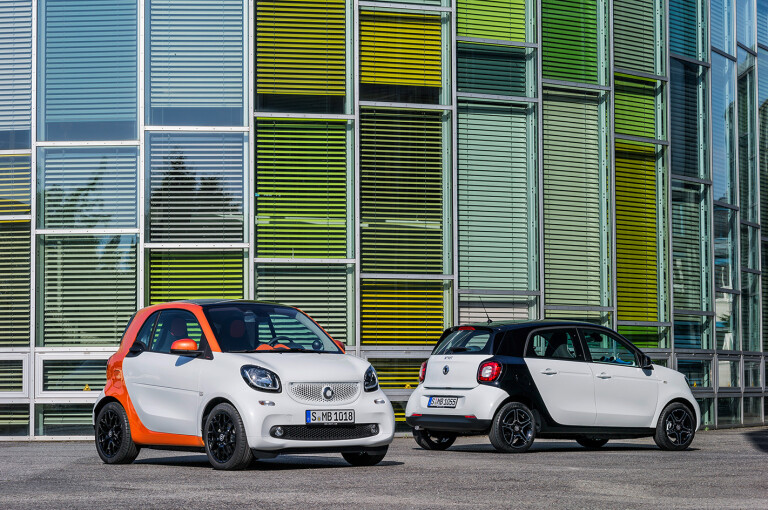
SMART’S new ForFour may be the smartest thing the Daimler-owned city-car specialist has ever done.
To be launched here in 2016, this small, tight-turning, four-seat, five-door hatchback will certainly expand the brand’s microscopic presence in Australia, where only 38 ForTwos were sold in the first half of 2014.
And it’s easy to imagine it having the same effect in other markets where supreme smallness isn’t such a big thing.
While the stumpy, two-seat ForTwo is popular in the squeezy cities of Germany, Italy and China, its appeal in less congested countries like Australia is as tiny as its dimensions.
With double the number of seats in an innovative and space-efficient package, the new ForFour will take Smart’s individual, youth-oriented design approach to a new audience.
Co-developed with Renault, the ForFour is closely related to the equally new Twingo.
Both cars have the same rear-engine and rear-drive layout used for the ForTwo right from Smart’s 1998 introduction.
And both Twingo and ForFour are to be produced at a Renault plant in Slovenia, while ForTwo production remains in France.
It’s not the first time the brand has launched a four-seat five-door. A decade ago, Smart teamed with Mitsubishi to produce its first ForFour, closely based on the 2003 front-engined and front-drive Colt, but it was a short-lived collaboration and the car was produced for only two years, from 2004 to 2006.
While that first ForFour had nothing in common with the first-generation ForTwo other than a superficial layer of Smart style, the company’s second attempt is different.
The two-seat and four-seat Smarts have the same engines, transmissions and chassis hardware.
The engines are transversely mounted, all-aluminium, petrol-burning triples, with their cylinders tilted 49 degrees from vertical to maximise cargo space.
From November, when the ForFour goes on sale in Europe, a choice of 52kW non-turbo 999cc and 66kW turbo 898cc engines will be offered. Both are likely for the Australian market, according to our Mercedes sources.
These will to be teamed with five-speed manual and six-speed double-clutch transmissions.
The new Smarts have wheel tracks 100mm wider than the current ForTwo and their front suspension adopts elements of the just superseded Mercedes C-Class, while the trademark De Dion rear suspension of all rear-engined Smarts has been redesigned for increased wheel travel.
One huge advantage of the rear-engine and rear-drive layout is that it permits larger steering angles at the front wheels. The ForFour’s turning circle, just 8.95 metres wall-to-wall, is outstanding.
And without an engine between the front wheels, there’s less need for steering assistance. Standard versions of the ForFour do without it, but a more direct, electric assist system will also be offered.
While Smart claims to have paid great attention to achieving good ride comfort, the new platform’s wider tracks and traction-enhancing rear-engine layout should also mean the ForFour handles better than other micro cars.
Smart also claims locating the engine in the rear is good for interior space efficiency.
Although the ForFour is 800mm longer than the new ForTwo, its overall length is a fraction under 3.5 metres.
With its rear and front passenger seats folded, the Smart can accommodate objects more than 2.2 metres long. With only the rear seats folded, maximum to-the-roof cargo capacity is 975 litres.
The interior is also more colourfully adventurous than the micro-car norm, especially in high-grade cars with their bright accents. The only disappointment is the fitment in the ForFour of flip-out instead of wind-up windows in the rear doors.
Smart claims safety was a major concern in designing both new models.
Mercedes-Benz safety engineers were involved in the development process and testing included much more than government-mandated tests. The ForTwo, for example, was subjected to car-to-car crashes with the much larger Mercedes-Benz S-Class and C-Class.
Both new Smarts are also equipped with an impressive array of passive and active safety equipment.
Five airbags are standard, including a driver’s knee bag, and so are ABS, ESP and a Crosswind Assist system to aid high-speed stability. Other advanced driver aids will be optional in the European market.
In Europe the ForFour will cost about €600 ($A1000) more than the ForTwo, and if the same applies in Australia, it will do much to counter Smart’s existing reputation for poor value.
If it’s as clever, safe and different as it seems, the new ForFour seems set to rewrite micro-car class benchmarks.

COMMENTS